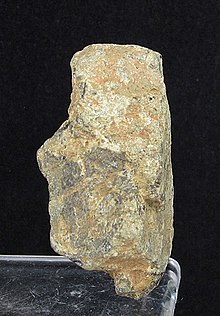The actinide or actinoid series encompasses the 15 metallic chemical elements with atomic numbers from 89 to 103, actinium through lawrencium. The actinide series derives its name from the first element in the series, actinium. The informal chemical symbol An is used in general discussions of actinide chemistry to refer to any actinide.

Scandium is a chemical element with the symbol Sc and atomic number 21.

Thorium is a weakly radioactive metallic chemical element with the symbol Th and atomic number 90. Thorium is silvery and tarnishes black when it is exposed to air, forming thorium dioxide; it is moderately soft and malleable and has a high melting point. Thorium is an electropositive actinide whose chemistry is dominated by the +4 oxidation state; it is quite reactive and can ignite in air when finely divided.

Uranium is a chemical element with the symbol U and atomic number 92. It is a silvery-grey metal in the actinide series of the periodic table. A uranium atom has 92 protons and 92 electrons, of which 6 are valence electrons. Uranium is weakly radioactive because all isotopes of uranium are unstable; the half-lives of its naturally occurring isotopes range between 159,200 years and 4.5 billion years. The most common isotopes in natural uranium are uranium-238 and uranium-235. Uranium has the highest atomic weight of the primordially occurring elements. Its density is about 70% higher than that of lead, and slightly lower than that of gold or tungsten. It occurs naturally in low concentrations of a few parts per million in soil, rock and water, and is commercially extracted from uranium-bearing minerals such as uraninite.

Uraninite, formerly pitchblende, is a radioactive, uranium-rich mineral and ore with a chemical composition that is largely UO2 but because of oxidation typically contains variable proportions of U3O8. Radioactive decay of the uranium causes the mineral to contain oxides of lead and trace amounts of helium. It may also contain thorium and rare-earth elements.
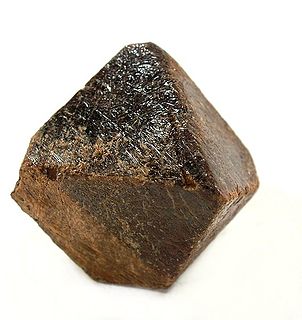
Pyrochlore2Nb2O6(OH,F) is a mineral group of the niobium end member of the pyrochlore supergroup. The general formula, A2B2O7, represent a family of phases isostructural to the mineral pyrochlore. Pyrochlores are an important class of materials in diverse technological applications such as luminescence, ionic conductivity, nuclear waste immobilization, high temperature thermal barrier coatings, automobile exhaust gas control, catalysts, solid oxide fuel cell, ionic/electrical conductors etc.

Euxenite or euxenite-(Y) is a brownish black mineral with a metallic luster.
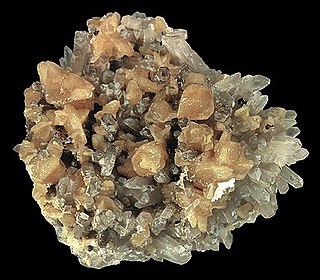
Monazite is a primarily reddish-brown phosphate mineral that contains rare-earth elements. Due to variability in composition, monazite is considered a group of minerals. The most common species of the group is monazite-(Ce), that is, the cerium-dominant member of the group. It occurs usually in small isolated crystals. It has a hardness of 5.0 to 5.5 on the Mohs scale of mineral hardness and is relatively dense, about 4.6 to 5.7 g/cm3. There are five different most common species of monazite, depending on the relative amounts of the rare earth elements in the mineral:

Uranium oxide is an oxide of the element uranium.
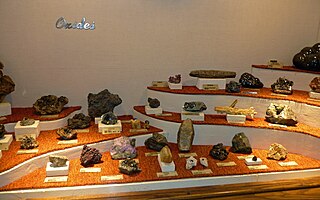
The oxide mineral class includes those minerals in which the oxide anion (O2−) is bonded to one or more metal alloys. The hydroxide-bearing minerals are typically included in the oxide class. The minerals with complex anion groups such as the silicates, sulfates, carbonates and phosphates are classed separately.

Uranium dioxide or uranium(IV) oxide , also known as urania or uranous oxide, is an oxide of uranium, and is a black, radioactive, crystalline powder that naturally occurs in the mineral uraninite. It is used in nuclear fuel rods in nuclear reactors. A mixture of uranium and plutonium dioxides is used as MOX fuel. Prior to 1960, it was used as yellow and black color in ceramic glazes and glass.

Environmental radioactivity is not limited solely to actinides; non-actinides such as radon and radium are of note. While all actinides are radioactive, there are a lot of actinides or actinide-relating minerals in the Earth's crust such as uranium and thorium. These minerals are helpful in many ways, such as carbon-dating, most detectors, X-rays, and more.

Uranium mining in Colorado, United States, goes back to 1872, when pitchblende ore was taken from gold mines near Central City, Colorado. The Colorado uranium industry has seen booms and busts, but continues to this day. Not counting byproduct uranium from phosphate, Colorado is considered to have the third largest uranium reserves of any US state, behind Wyoming and New Mexico.

Betafite is a mineral group in the pyrochlore supergroup, with the chemical formula (Ca,U)2(Ti,Nb,Ta)2O6(OH). Betafite typically occurs as a primary mineral in granite pegmatites, rarely in carbonatites. Defined by the B-site atom Ti, Atencio et al.(2010) combined and considered the ideas portrayed in (Hatert and Burke)(2008) and a modernization of (Hogarth)(1977) system for nomenclature of pyrochlore and betafite in order to further rationalize the naming process of this grouping of minerals. Therefore, Atencio et al. (2010), states that only two of the mineral species that were formerly recognized under the previous nomenclature system of betafite in Hogarth (1977) are now recognized. They are oxyuranobetafite and oxycalciobetafite. Now the term betafite is a synonym or varietal group name under the pyrochlore super group (Christy and Atencio 2013).

Yttrium is a chemical element with the symbol Y and atomic number 39. It is a silvery-metallic transition metal chemically similar to the lanthanides and has often been classified as a "rare-earth element". Yttrium is almost always found in combination with lanthanide elements in rare-earth minerals, and is never found in nature as a free element. 89Y is the only stable isotope, and the only isotope found in the Earth's crust.
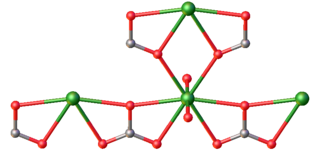
Uranyl carbonate refers to the inorganic compound with the formula UO2CO3. Also known by its mineral name rutherfordine, this material consists of uranyl (UO22+) and carbonate (CO32-). The compound is a polymeric, each uranium(VI) center being bonded to eight O atoms. Hydrolysis products of rutherfordine are also found in both the mineral and organic fractions of coal and its fly ash and is the main component of uranium in mine tailing seepage water.

The Nabarlek Mine is a uranium mine in the Northern Territory of Australia which was productively worked only in 1979. The deposit sits within the Alligator Rivers Uranium Field approximately 62 kilometres (39 mi) northeast of Jabiru. It was discovered by Queensland Mines Limited in 1970 by following up an intense airborne radiometric anomaly.
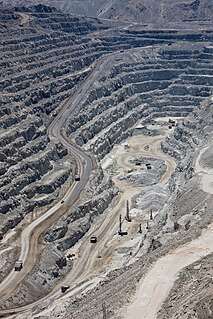
Uranium mining in Namibia is of considerable importance to the national economy. In 2020, Namibia produced 11% of uranium worldwide, ranked as the 4th largest producer, behind Kazakhstan, Canada, and Australia.
Bijvoetite-(Y) is a very rare rare-earth and uranium mineral with the formula (Y,REE)8(UO2)16(CO3)16O8(OH)8·39H2O. When compared to the original description, the formula of bijvoetite-(Y) was changed in the course of crystal structure redefinition. Bijvoetite-(Y) is an example of natural salts containing both uranium and yttrium, the other examples being kamotoite-(Y) and sejkoraite-(Y). Bijvoetite-(Y) comes from Shinkolobwe deposit in Republic of Congo, which is famous for rare uranium minerals. The other interesting rare-earth-bearing uranium mineral, associated with bijvoetite-(Y), is lepersonnite-(Gd).

Uranium acid mine drainage refers to acidic water released from a uranium mining site using processes like underground mining and in-situ leaching. Underground, the ores are not as reactive due to isolation from atmospheric oxygen and water. When uranium ores are mined, the ores are crushed into a powdery substance, thus increasing surface area to easily extract uranium. The ores, along with nearby rocks, may also contain sulfide. Once exposed to the atmosphere, the powdered tailings react with atmospheric oxygen and water. After uranium extraction, sulfide minerals in uranium tailings facilitates the release of uranium radionuclides into the environment, which can undergo further radioactive decay while lowering the pH of a solution.
